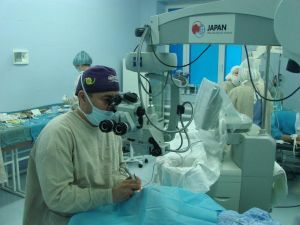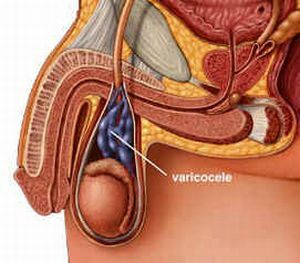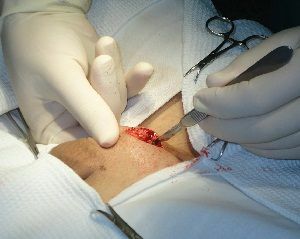 Varicocele is a disease during which varicose veins of the lobular plexus of the spermatic cord occur.
Varicocele is a disease during which varicose veins of the lobular plexus of the spermatic cord occur.
This plexus is considered an element of the spermatic cord, leaves from each testicle within the inguinal canal and forms an internal testicular vein at the exit.
This disease affects to some extent up to 20% of men and is the most common cause of testicular dysfunction and one of the most likely culprits of male infertility.
Varicocele significantly reduced the flow of blood into the testicles, accompanied by atrophy and, as a consequence, a violation of functions.
Contents
- Microsurgical revascularization
- Pros and cons of procedure
- Technique for conducting
- Possible complications
- Postoperative period
- Opinion of specialists and patients
- Cost of surgery in Russia
Microsurgical revascularization
Microsurgical revascularization of the testicle is considered the only successful method of getting rid of varicocele,the testicular vein.
During the surgical operation, the ovarian vein moves into the vein of the epigastrium.
The operation is considered to be microsurgical due to the fact that special microscopes are used in the operation, with the help of which the doctor correctly places the epigastric vein, replacing it with varicose veins.
Also such an operation, which is also microvascular, is the only possible one, after which the blood flow in the testicles resumes in full immediately, and not after a week, as happens after other operations.
Advantages and disadvantages of the procedure
An advantageous difference between a microsurgical operation and other types of surgery is that the blood circulation in the testicle does not stop  and after it there is no painful sensation.
and after it there is no painful sensation.
Because after it the probability of occurrence of such disease as a dropsy of the testicle is minimized.
Optical magnification with microscopes allows you to sew the testicle veins into abdominal veins located on the surface, in which the blood supply is carried out in normal mode.
Of the minus revascularization of the testicle is the complexity of the operation, its high cost, as well as a long postoperative period, caused by the need for observation in the hospital.
Technique for conducting
The operation is performed under general anesthesia and can be performed at each degree of varicocele development.
Preparation for intervention is no different from preparing for other types of operations performed in the groin. First of all, urine and blood tests, as well as shaving of hair in the groin area, are necessary.
 The technology of the operation consists in scalping the varicose veins from the side of the varicocele and replacing it with a healthy one. For this purpose, as a rule, an epigastric vein is used.
The technology of the operation consists in scalping the varicose veins from the side of the varicocele and replacing it with a healthy one. For this purpose, as a rule, an epigastric vein is used.
When performing surgery in the lower abdomen, the surgeon produces an incision length of 5-6 cm parallel to the inguinal canal. The canal is opened and an enlarged vein is extracted from the resulting incision for its entire length.
Synchronously with this from the venous plexus, the doctor chooses a suitable part of the epigastrium. Then the selected piece of the epinephrine vein is sutured to the site of the former testicle vein, the incision is sutured.
Possible complications of
The operation to eliminate varicocele by microsurgical revascularization of the testicle is considered to be the most effective method of surgical intervention.
Despite the complexity of execution and the relatively high cost, the reviews of patients cured of varicocele have only positive coloring.
When telling about their health after the operation, patients notice a decrease in the size of the veins due to varicose almost immediately after the operation, although the final effect is observed after 3-6 months.
No matter how well the surgical procedure is performed, after it there is a possibility of occurrence of some complications:
- Lymphostasis .Violation of the outflow of lymph or its stasis in the lymphatic vessels. Usually manifested in the early stages of postoperative recovery. The cause of the manifestation of lymphostasis can be ligation or deformation of lymph vessels during surgery.
- Pain .Such an operation is carried out with the purpose of reducing or eliminating painful sensations and the causes of their occurrence. In nine out of ten cases after the operation, the pain disappears, however, 3-5% of patients in the initial period after the intervention experience pain in the testicle, which last for several months.
- Hydrosele .This is a congestion of serous fluid in the intercostal space of the testicle. This side effect occurs quite rarely, within 0.5-8% of all operated patients.
There are also other less common postoperative complications: infectious diseases, bleeding, deformation of nerves in the inguinal canal.
Postoperative period
The postoperative period is no different from other similar operations. The patient takes antibiotics and pain medications.
If necessary, the sterile bandage is replaced, the seams are removed usually after 8-9 days. 
In the absence of side effects and complications after surgery is not available, then the patient must necessarily undergo an examination in the polyclinic at the place of residence at a frequency of 1 month, 6 months and 18 months after the operation.
For quick rehabilitation of the patient, an individual plan for applying the loads is selected, and various preventive measures are prescribed.
Due to the fact that the main reason for the operation is already available or suspected infertility, it is necessary to periodically check the spermogram.
Opinion of specialists and patients
In my practice, I have never managed to return the patient to a full life with varicocele without resorting to microsurgical revascularization of the testicle.
This operation is based primarily on the hands of an experienced physician and the reliability of the used optics. The best method of getting rid of such a disease, as varicocele has not yet been invented.
Sergey Leonidovich
Many patients are embarrassed to come with such a delicate problem or are afraid of the frightening name of the operation. There is nothing wrong with this, millions of people have been treated by this method and everything is fine with them.
Nikolay Valerianovich
Reviews of patients who underwent microsurgical revascularization of the testicle:
Have made such an operation to the husband. We really want children, my husband is already 35, we have been married for four years and still do not. After examination, the doctor diagnosed varicocele and recommended surgery. I underwent surgery last year, and the result is 10 weeks.
Alina
There were problems with the left testicle. The doctor diagnosed varicocele and had to go to surgery. After its carrying out the condition almost immediately improved, everything began to come back to normal, almost nothing hurts. We decided to have a third child with my wife.
Sergey
Cost of surgery in the Russian Federation
Microsurgical revascularization of the testicle is considered to be an effective and rather expensive procedure. The cost of conducting it is different in each of the clinics and varies within from 43 thousand rubles.up to 56 thousand rubles .
 Venotonizing preparation Venolek: user's manual, reviews of doctors and patients, pluses and minuses of medication and other useful information.
Venotonizing preparation Venolek: user's manual, reviews of doctors and patients, pluses and minuses of medication and other useful information. Vascular pathology in which laser photocoagulation of vessels is indispensable. How to prepare for the procedure and what do doctors and patients say about its effectiveness?
For example, in the "Modern Clinic" Androdoktor "the cost is from 43 thousand rubles., And the operation in the CC MPRA on the basis of the Federal State Institution" Medical and Rehabilitation Center of the Ministry of Health and Social Development of the Russian Federation "will have to pay 56 thousand rubles.
Microsurgical revascularization is very difficult in carrying out an operation not only for the patient, but also for the surgeon, which to some extent limits the possibilities of conducting it.
But exactly this method of surgical intervention should be used for all clinical manifestations of varicocele, without exception, especially with severe pain in the scrotum or changes in the spermogram.
All other types of operations can not only not give the desired effect, but also aggravate the course of the disease.
